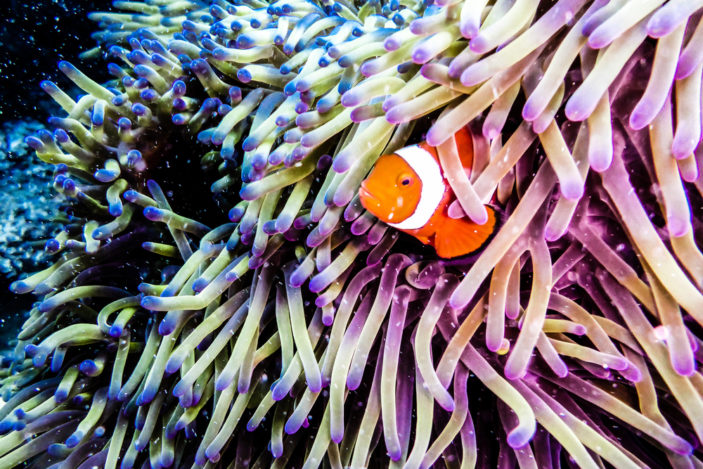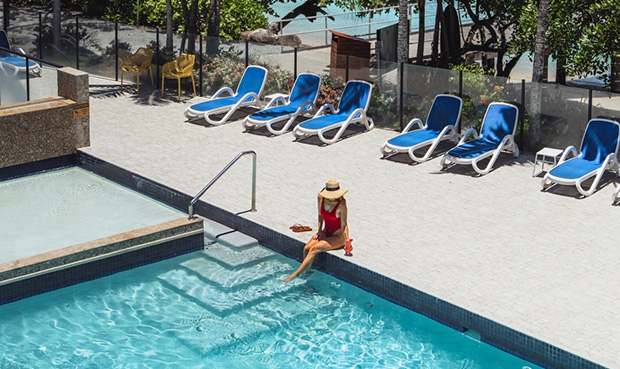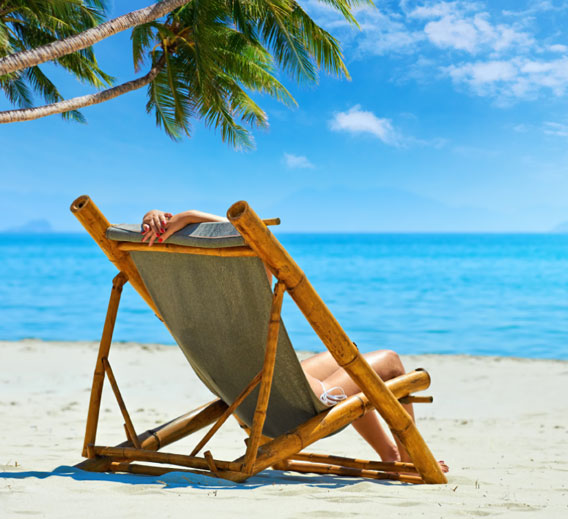Are you in the middle of planning a once-in-a-lifetime trip to the breathtaking Great Barrier Reef in Queensland, Australia? If so, you are likely curious about the Great Barrier Reef and have some questions in mind about this spectacular natural wonder of the world. Whether you are an Aussie holidaying in Queensland or visiting from overseas, in this article we shall address some of the most frequently asked questions by visitors to the Great Barrier Reef!
Where is the Great Barrier Reef located?
The Great Barrier Reef is an astonishing 2,600 kilometres (or 1600+ miles) long, and therefore stretches its away along a significant amount of the coastline of what is known as Australia’s “sunshine state”, Queensland, which is located on the eastern side of the country. The southern tip of the Great Barrier Reef is found off the coast of southern Queensland, in Bundaberg, and this magnificent structure stretches all the way up to Australia’s most northern point, Cape York.
How big is the Great Barrier Reef?
Did you know that the World Heritage-listed (as of 1981) Great Barrier Reef is the largest reef system found on planet Earth? More than 2,900 individual reefs together make up the Great Barrier Reef, and over 900 stunning islands (of varying landscapes and vegetation) are dotted amongst the Reef. Amazingly, the Great Barrier Reef can be identified from outer space! After all, this natural ocean structure is spread across a mammoth 300,000 square kilometres.
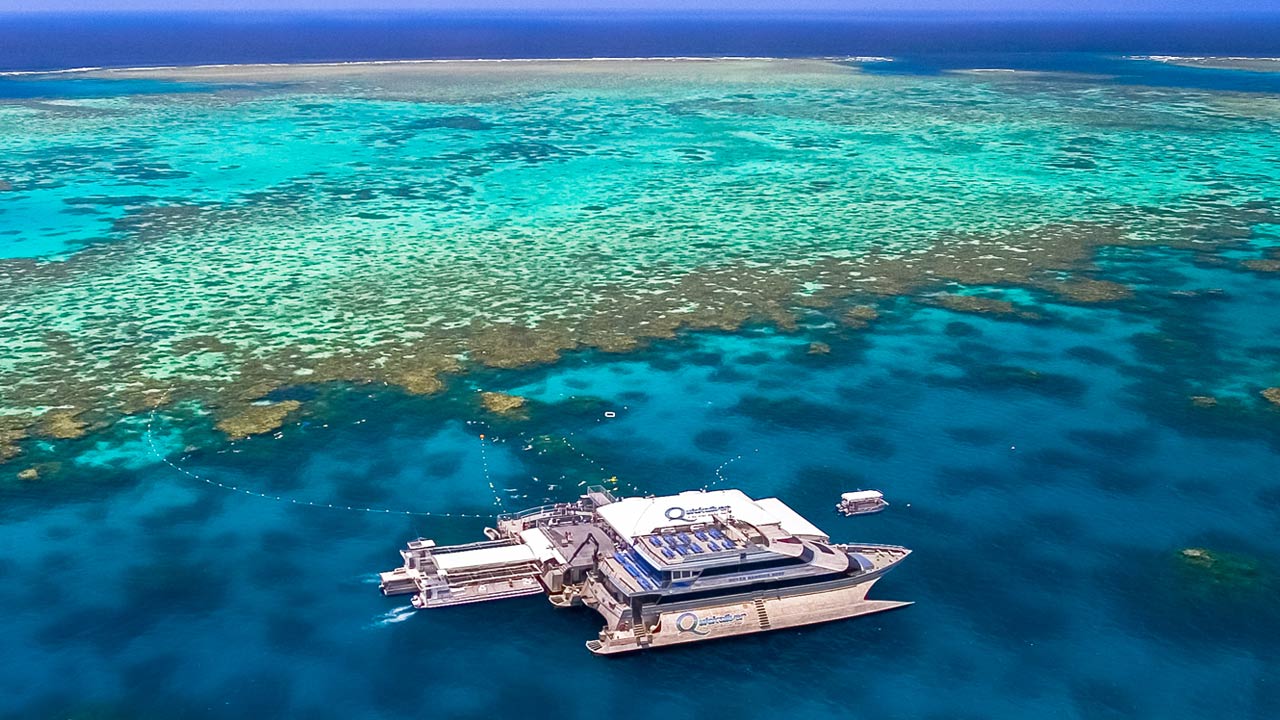
Image Credit: quicksilver-cruises.com
How many people visit the Great Barrier Reef each year?
More than two million (yes, two million!) people make their way to explore the breathtaking beauty of the Great Barrier Reef in Queensland each year, including Queensland locals, Australians visiting from interstate and international visitors from all over the world! The Great Barrier Reef is vital to Australia’s economy, as tourism to the area contributes roughly $6 billion revenue to the country’s economy.
What types of animals call the Great Barrier Reef home?
The Great Barrier Reef is home to an abundance of exquisite marine life, both big and small. More than 1,600 different species of fish can be found among the Great Barrier Reef’s hard and soft coral (of which there are roughly 400 species) reef systems. Amazingly, the Great Barrier Reef is home to all but one of the world’s species of marine turtles! Turtles are the number one request by visitors to the Reef when it comes to spotting animals beneath the ocean’s surface.
A huge variety of molluscs (including giant clams) also call the Great Barrier Reef home, in addition to numerous crustaceans (e.g. crabs, crayfish and prawns), fascinating jellyfish and majestic rays. Thirty different species of whales and dolphins can be found in the waters of the Great Barrier Reef, and fascinatingly, approximately 200 species of marine birds call the region home, too.
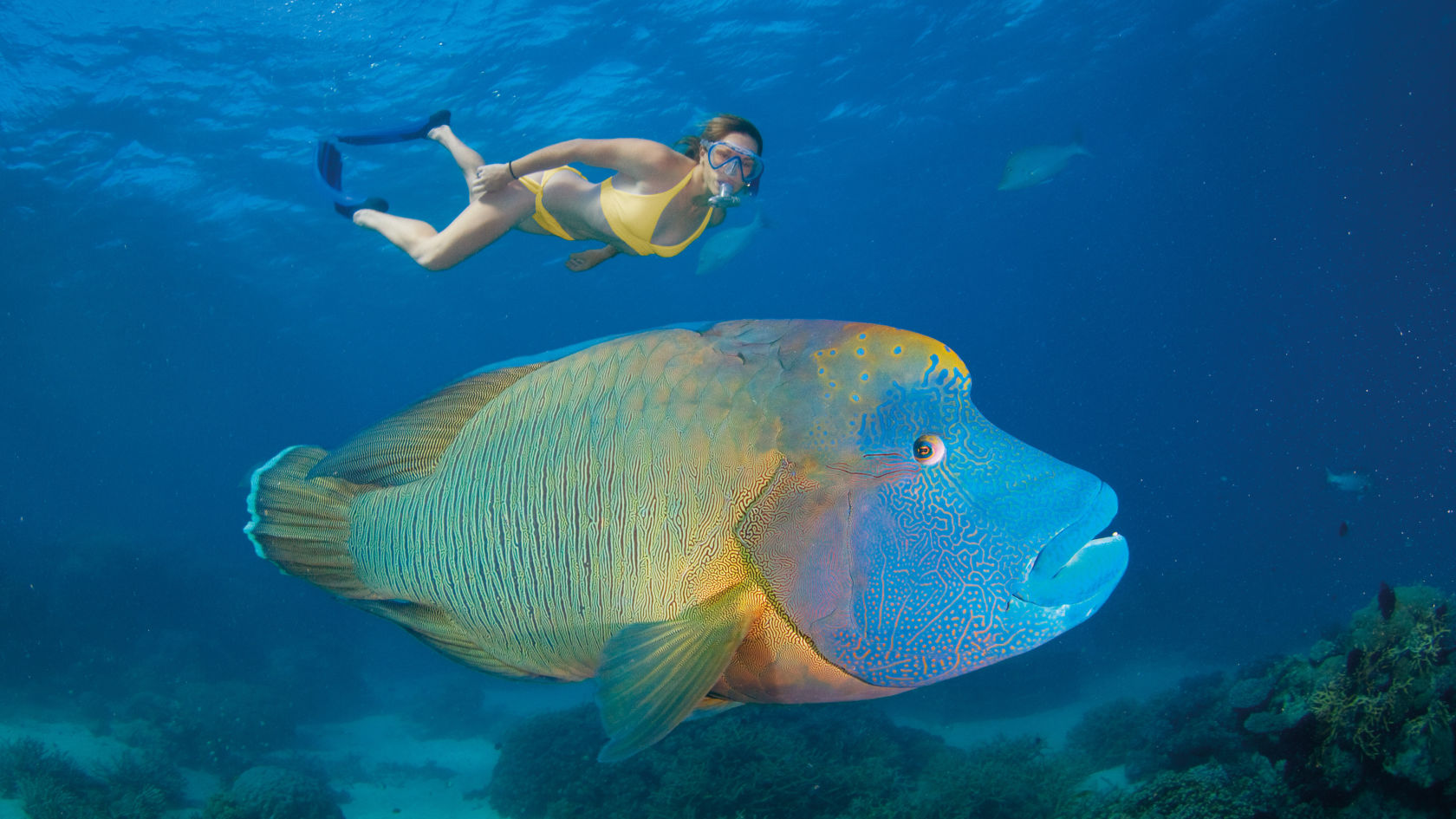
Image Credit: barrierreef.org
Where are the best places to visit the Great Barrier Reef?
Two of the ultimate locations to visit with regards to exploring the Great Barrier Reef are Cairns and Port Douglas.
Cairns
Cairns is famous around the world for being the gateway to the Great Barrier Reef, thanks not only to its relative proximity to some of the most outstanding parts of the Reef, but also due to its international and domestic airports, connecting visitors from all over Australia and the globe to this incredible region. It is good to remember that the majority of day trips to the Great Barrier Reef depart from and finish up in the seaside town of Port Douglas (located one hour north of Cairns).
If you intend to visit Cairns and the Great Barrier Reef but would prefer not to travel to Port Douglas, and/or wish to explore the Reef straight from the safety of a tropical island shore, Fitzroy Island is the perfect place for you. This stunning tropical island paradise is located a mere 30km off the coast of Cairns and is accessible by means of a 45-minute Fast Cat ride from the Cairns Marina. You can elect to explore Fitzroy Island and the surrounding Great Barrier Reef for just the day or instead stay and soak up all there is to enjoy at the island’s exclusive resort.
Did you know that Australia’s number one beach, Nudey Beach (as per Australia’s Top 101 Beaches Awards in 2018), is located on Fitzroy Island? It’s hardly surprising once you feast your eyes on the magnificence that is Nudey Beach – think pristine white sand, backed by granite boulders and lush rainforest vegetation, and of course, its warm and inviting turquoise ocean waters, with the shore just metres from the reef. Nudey Beach is undoubtedly one of Australia’s finest locations from which to explore the magic of the Great Barrier Reef with your snorkel, mask and fins in hand.
In addition to incredible snorkelling at Fitzroy Island (during which you’ll have the opportunity to spot stunning tropical fish, such as clown fish, majestic marine turtles and numerous species of coral), there are a number of other amazing activities on offer, including visiting the island’s Turtle Rehabilitation Centre, bouncing around on the Giant Ocean Trampoline, taking a glass bottom boat tour, exploring the island’s tropical vegetation via a variety of walking tracks and glass-bottom sea kayaking. Fitzroy Island Resort has accommodation options to suit all tastes and budgets.
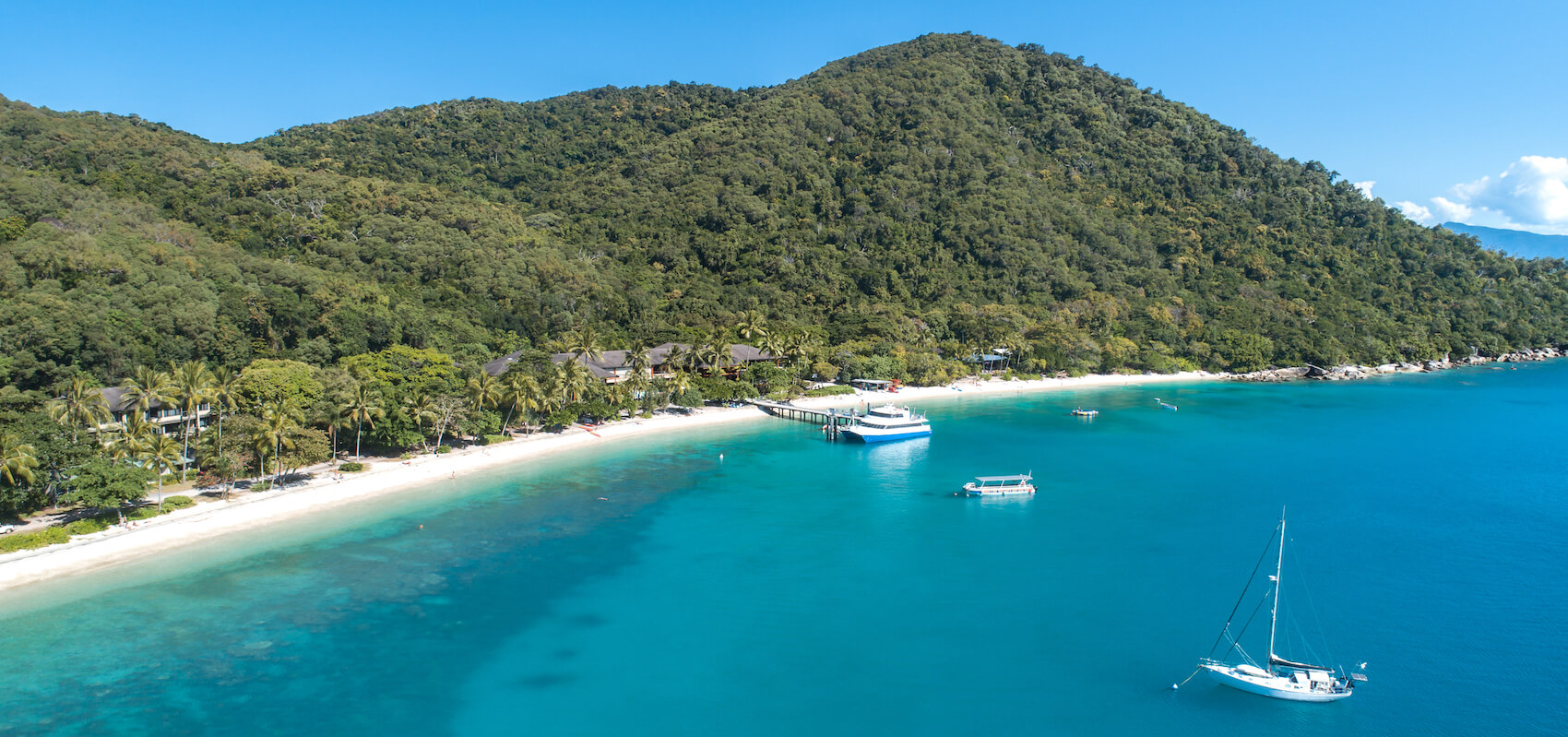
Port Douglas
Whether you choose to take part in a local organised tour to the Low Isles (two islands close to the coast of Port Douglas, connected by a coral cay) or the outer reef, Port Douglas is the main launching point for day tours to the Great Barrier Reef. Thankfully, there are tour options to suit everyone. The majority of tours run for a full or half day, with options to suit those short on time, too (e.g. just a few hours). You can choose from a large boat, such as the famous Quicksilver, or a smaller, more intimate catamaran, such as Sailaway. Snorkelling and food/refreshments are included as part of your ticket in the majority of cases, and scuba diving can be added to your package on some vessels (even for beginners!).
Port Douglas, famous for its beautiful coconut palm-lined Four Mile Beach, is a very laidback and welcoming seaside town. In addition to its stunning natural beauty, Port Douglas is also famous for its food scene, whereby visitors can indulge in one (or many!) of its amazing cafes, pubs and fine dining options, where local produce is a special feature.
What time of year is best to visit the Great Barrier Reef?
Regardless of what time of year you venture to the Great Barrier Reef, it is magical. The area attracts the most visitors between the months of June and September (‘high season’). Despite being winter for most of this period, weather conditions are optimal in Tropical Far North Queensland, and you can expect beautiful warm, balmy, tropical weather with reduced humidity and minimal rainfall. Temperatures at this time of year often hover between a comfortable 20 and 30°C. (These particular four months, however, feature a number of different Australian school holiday periods (which tend to vary by state); it may be of benefit to you to research said periods and travel outside of these times, which can save increased costs and crowds.)
In comparison, the ‘low season’ which is often referred to by Aussies as the ‘wet season’ or sometimes ‘stinger season’ (marine stingers) runs from November through to May, approximately. Tropical rainfall over these months is much heavier and falls much more regularly compared to the busier season. In order to protect yourself, it is recommended that when visiting the beach during these months you swim inside the dedicated marine stinger enclosures and wear a stinger suit when visiting the reef (as per your chosen tour operator).
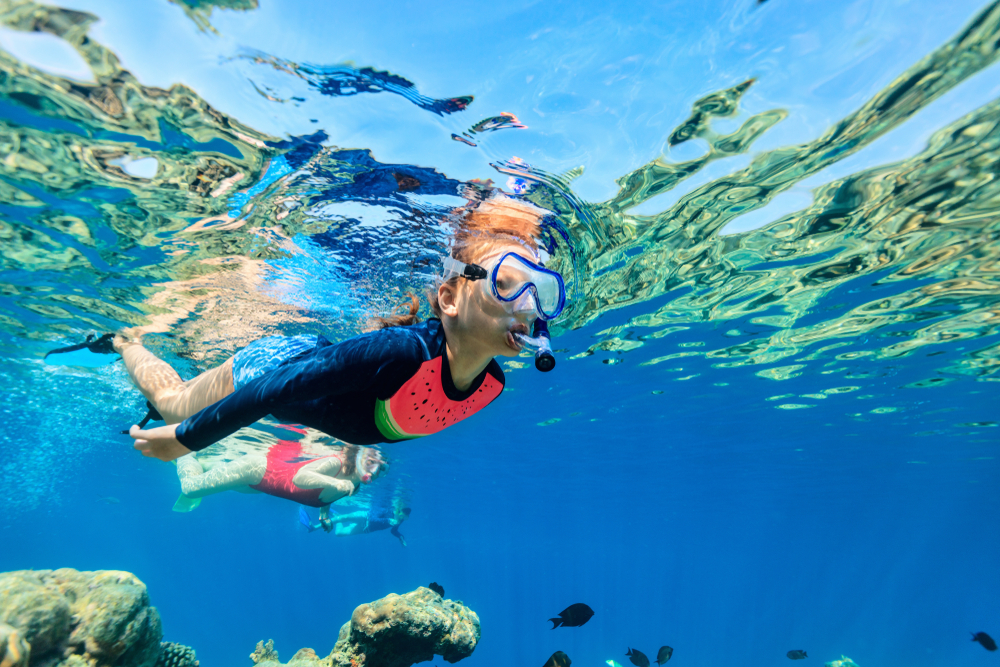
What are the best ways to see and experience the Great Barrier Reef?
Whether you choose to visit the outer reef or a nearby tropical island (such as Fitzroy Island near Cairns, or the Low Isles near Port Douglas), there are a number of enjoyable ways to explore the breathtaking beauty that is the Great Barrier Reef. The most popular way to explore the reef is most certainly via snorkelling. Snorkelling is a lovely, relaxing way to experience the reef and all the beautiful animals that inhabit it. It is also a great budget-friendly option, too. The majority of tour operators to the Reef include snorkel hire as part of your ticket (be sure to check upon booking).
While visiting the Great Barrier Reef, you may also like to try your hand at scuba diving (or perhaps you already have experience under your belt!). Scuba diving is an incredible means for exploring the Great Barrier Reef, enabling you to get right up close to all the magnificent coral and sea life below the ocean’s surface. A number of tour operators to the Reef offer the option of scuba diving in addition to snorkelling (at an extra cost).
If snorkelling or scuba diving aren’t your thing, you aren’t confident in the water or you are simply looking for further enjoyable ways to explore the magic of the Reef, you might like to consider taking a glass bottom boat tour, hiring sea kayaks (consider glass-bottom kayaks for a truly amazing experience!), and/or if your budget allows, a helicopter or seaplane tour! Experiencing the Great Barrier Reef from the air is an experience like no other!
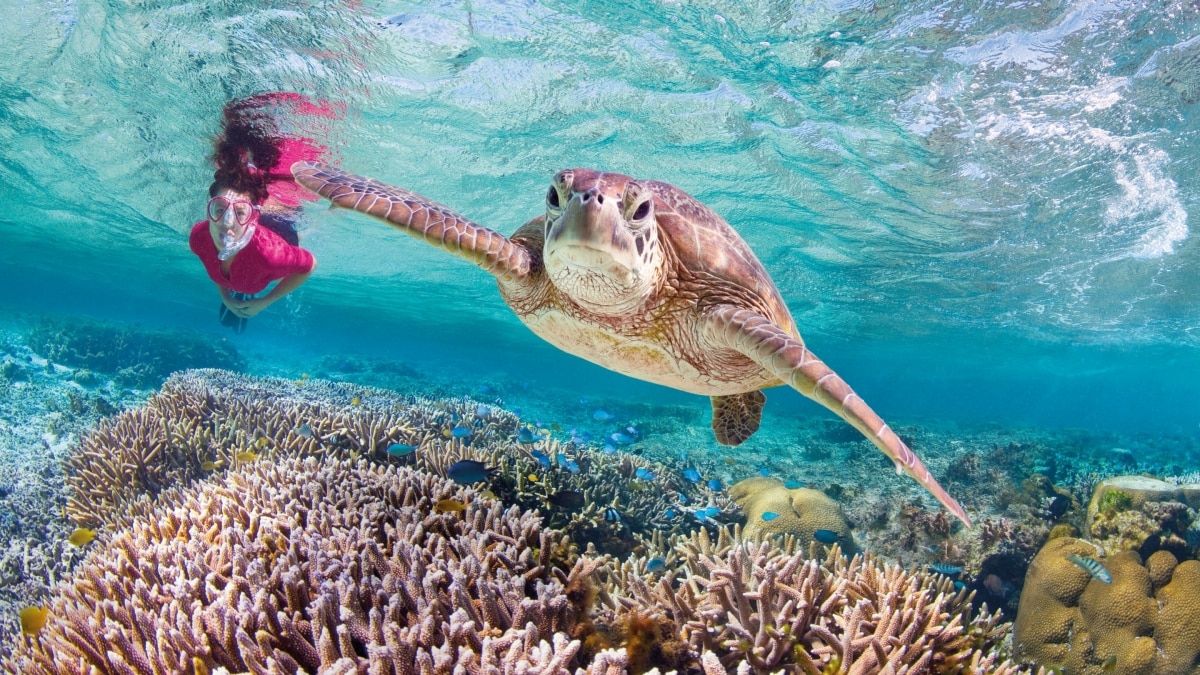
Image Credit: australia.com
Where are the best places to see turtles near Cairns on the Great Barrier Reef?
Marine turtles are far and beyond the most requested animal for spotting from visitors to the Great Barrier Reef. Astonishingly, six of the world’s total of seven different marine turtle species live amongst the Great Barrier Reef. These species include: the famous Green Turtle, as well as Hawksbill, Leatherback, Flatback, Loggerhead and Olive Ridley Turtles.
Two of Tropical Far North Queensland’s most popular regions of the Great Barrier Reef are Turtle Bay (Agincourt Reef) and Opal Reef, both of which are visited regularly by tour operators in the area. Amazingly, four of the six above species of marine turtles are found in these locations. The best time of year for spotting marine turtles is late Spring through to early summer (i.e. late October through to early December).
Turtles are also spotted on a regular basis in the tropical waters that surround Fitzroy Island, just 30km off the coast of Cairns, as well as Green Island. Fitzroy Island is a must-visit if you are a turtle lover, thanks to it being the home of the Cairns Turtle Rehabilitation Centre. Each day (subject to conditions), the Centre welcomes visitors through its doors for an intimate tour, where you can see firsthand the amazing work that goes on at the fully volunteer-run centre, with the objective of caring for sick and/or injured turtles for release back into their ocean home.
So, there you have it – we hope we have answered some of your questions about the magnificent Great Barrier Reef. We can’t wait to welcome you to this magical part of the world very soon!


